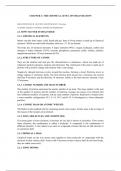CHAPTER 2: THE CHEMICAL LEVEL OF ORGANIZATION
BOOK: PRINCIPLES OF ANATOMY AND PHYSIOLOGY 13th edition.
AUTHORS: GERARD J. TORTORA AND BRYAN DERRICKSON.
2.1. HOW MATTER IS ORGANIZED:
2.1.1. CHEMICAL ELEMENTS:
Matter can take three states: solid, liquid and gas. Inert or living matter is made up of chemical
elements. Which are indivisible elements, there are 117, 92 are natural.
The body has 26 chemical elements; 4 major elements (96%): oxygen, hydrogen, carbon and
nitrogen; 8 minor elements (3.6%): calcium, phosphorus, potassium, sulfur, sodium, chlorine,
magnesium and iron; 14 trace elements (0.4%).
2.1.2. STRUCTURE OF ATOMS:
They are the smallest unit and give the characteristics to substances. Atoms are made up of
subatomic particles (protons, neutrons and electrons). The central part of the atom is made up of
protons with a positive charge and neutrons with a zero charge.
Negatively charged electrons revolve around the nucleus, forming a cloud. Electrons move in
energy regions or electronic shells. The first electron shell always has 2 electrons, the second
shell has 8 electrons, and the third has 18 electrons. Iodine is the most massive element; it has
53 electrons.
2.1.3. ATOMIC NUMBER AND MASS NUMBER:
The number of protons represents the atomic number of an atom. The mass number is the sum
of the number of protons and the number of neutrons. Isotopes are atoms of an element that
have different numbers of neutrons, but the same number of protons. Radioactive isotopes have
a more unstable configuration: H-3, C-14, O-15 and O-19. It disintegrates to form subatomic
particles.
2.1.4. ATOMIC MASS OR ATOMIC WEIGHT:
The Dalton is the standard unit for measuring atomic mass (sum). Atomic mass is the average of
the masses of the isotopes of an element.
2.1.5. IONS, MOLECULES AND COMPOUNDS:
If an atom gains or loses electrons, it becomes an ion, this is known as ionization. If two atoms
share electrons, the combination is called a molecule. A compound is the combination of
different elements. A free radical is an atom or compound of atoms that has an odd electron in
its outermost shell.
2.2. CHEMICAL LINKS:
Chemical bonds are the way atoms come together to form molecules or compounds with the
electrons in their valence shell. Atoms with 8 electrons in their valence shell do not form bonds,
they are stable (octet rule).
2.2.1. IONIC BONDS:
, It occurs when ions of opposite charges are held together. Ionic compounds that degrade into
positive and negative ones are called electrolytes; when dissolved, their solution can conduct
electric current.
2.2.2. COVALENT BOND:
It consists of sharing 2 or more pairs of electrons between two atoms, the greater the pairs
shared, the stronger the bond. It is the most common link in the human body. One shared pair of
electrons creates a single bond, 2 pairs a double bond, and 3 pairs a triple bond.
When the force of attraction that the atoms exert on the electrons is the same, it is said to be a
nonpolar bond, otherwise it is said to be polar. The ability to attract electrons is called
electronegativity.
2.2.3. HYDROGEN BRIDGE LINKS:
It is formed when a positively charged hydrogen atom attracts the partial negative charge of
adjacent electronegative atoms. They are weak compared to ionic and covalent bonds. They are
responsible for joining molecules or parts of large molecules. Together the hydrogen bond
bonds give strength, stability and shape
2.3. CHEMICAL REACTIONS:
They occur when new chemical bonds are formed or destroyed. They are the basis of vital
functions. The initial substances are known as reactants and the final substances are known as
products. The reactants and products have different chemical properties, since the atoms inside
them have been rearranged. Metabolism is the sum of all the chemical reactions that occur in the
body.
2.3.1. FORMS OF ENERGY AND CHEMICAL REACTIONS:
Energetic is the ability to do work. There are two types of energy, potential energy, which is
related to its position, and kinetic energy, which is related to its movement. The amount of
energy present at the beginning and end of a chemical reaction is the same (law of conservation
of energy).
2.3.2. ENERGY TRANSFER IN CHEMICAL REACTIONS:
Chemical bonds represent stored chemical energy. There are two types of reactions; exergonic
reactions, which release more energy than they absorb, and endergonic reactions, which absorb
more energy than they release. The energy released in endergonic reactions is used in exergonic
reactions, for example in cellular respiration.
a. Activation energy:
It is the energy necessary to initiate the formation or breaking of a chemical bond. It begins with
the collision of particles with kinetic energy. The probability of a chemical reaction occurring is
greater when there is a higher concentration of particles and a high temperature.
b. Catalysts:
Catalysts are substances that speed up chemical reactions by reducing the amount of activation
energy needed. It is responsible for orienting the particles for a more effective collision. If they
are not modified, they can intervene in multiple reactions.
2.3.3. TYPES OF CHEMICAL REACTIONS:




